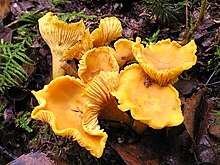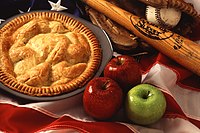Pacific Northwest cuisine


| Part of a series on |
| American cuisine |
|---|
 |
| Part of a series on |
| Canadian cuisine |
|---|
 |
|
|
Pacific Northwest cuisine is a North American cuisine that is found in the Pacific Northwest, i.e. the states of Oregon, Washington, Idaho and Alaska, as well as the province of British Columbia and the southern portion of the territory of Yukon, reflecting the ethnic makeup of the region, with noticeable influence from Asian and Native American traditions. With significant migration from other regions of the US, influences from Southern cuisine brought by African Americans as well as Mexican-American cuisine as Latinos migrate north from California, can be seen as well.[1]
Seattle's Pike Place Market is notable regarding this culinary style, along with Portland and Vancouver. Former restaurant critic of The New York Times Frank Bruni wrote of Seattle in June 2011, "I'm hard-pressed to think of another corner or patch of the United States where the locavore sensibilities of the moment are on such florid (and often sweetly funny) display, or where they pay richer dividends, at least if you're a lover of fish."[2]
Foods and dishes
[edit]Common ingredients include salmon, shellfish, and other fresh seafood, game meats such as moose, elk, or caribou, wild mushrooms, berries, small fruits, potatoes, kale, and wild plants such as fiddlehead ferns and even young pushki. Smoking fish or grilling seafood on cedar planks are techniques often used in this cuisine.[3] Since the 1980s, Northwest cuisine has begun to emphasize the use of locally produced craft beer and wine.
There is generally an emphasis on fresh ingredients, simply prepared.[4] Unlike other cuisine styles, there are various recipes for each dish with none being considered more or less correct than the others. This has led some food writers to question whether it truly is a "cuisine" in the traditional sense of the word.[5]
Many food carts and food trucks in the Northwest specialize in fusion cuisine, such as bulgogi burritos, deep-fried sushi rolls, Korean tacos and "Japanese-style" hot dogs.[6] Other foods found in Seattle with a heavy Asian influence include a unique style of teriyaki,[7] along with a sushi roll with salmon and cream cheese (the Seattle roll).[8] Food carts also spawned the Seattle Dog, a hot dog with cream cheese.[9]
See also
[edit]- Tlingit cuisine, the food of the Tlingit people, an indigenous people from Alaska, British Columbia, and the Yukon
References
[edit]- ^ A taste of Seattle: A Pacific Northwest culinary pilgrimage Janis Cooke Newman, San Francisco Chronicle, 10-21-01
- ^ Bruni, Frank (10 June 2011). "Seattle, A Tasting Menu". The New York Times. Retrieved 2011-06-11.
- ^ Caryn Brooks (September 18, 2007). "Can you package the Pacific Northwest in a Big Apple restaurant?". Associated Press – via USA Today.
- ^ Bret Thorn (May 15, 2000), "Exporting nirvana: Northwest's cuisine migrates across the U.S.", Nation's Restaurant News
- ^ Jamie Neely (November 18, 1988), "Authors Disdain Northwest Cuisine Notion as Mere Hype", Spokane Chronicle
- ^ Fusion Of Food Carts Continue To Stir Melting Pot, Oregon Public Broadcasting
- ^ Edge, John T. (January 5, 2010). "A City's Specialty, Japanese in Name Only". The New York Times. Retrieved October 15, 2022.
- ^ Atkinson, Greg (September 9, 2007). "Beyond PB&J". The Seattle Times Pacific Northwest Sunday Magazine. Retrieved February 3, 2010.
- ^ Raskin, Hanna (August 29, 2012). "Streets of Philadelphia". The Seattle Weekly. pp. 11–15. Retrieved September 3, 2012.
